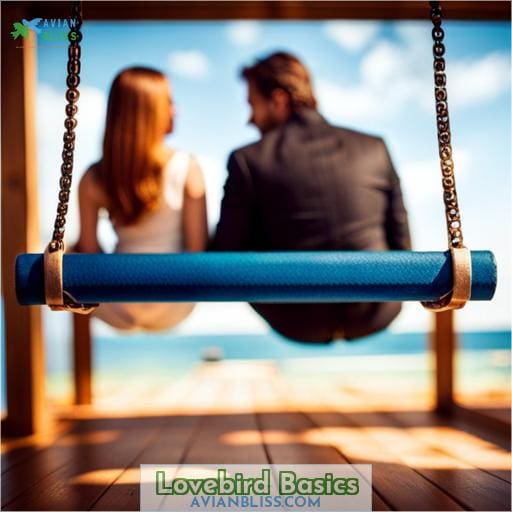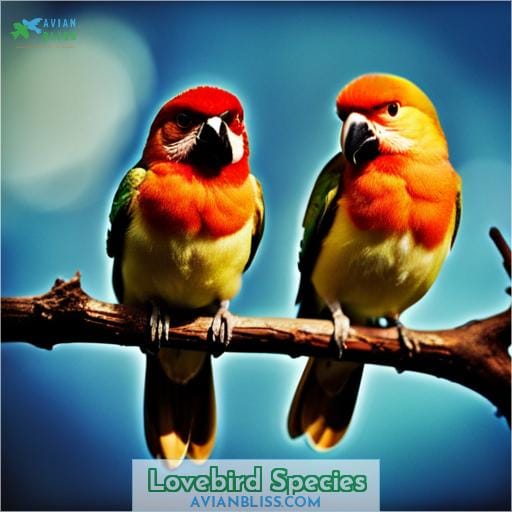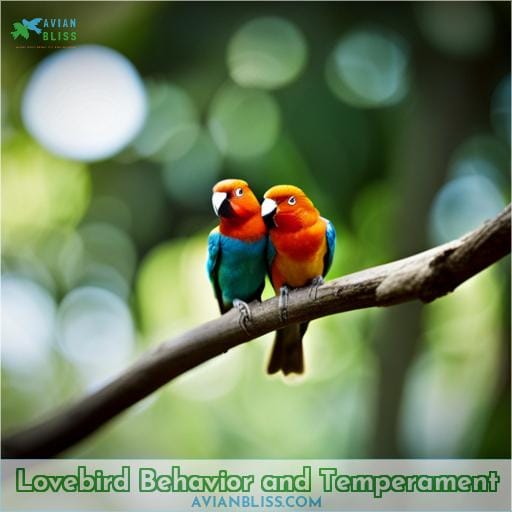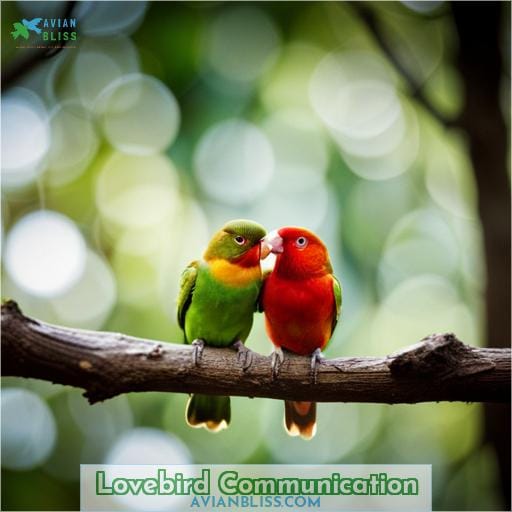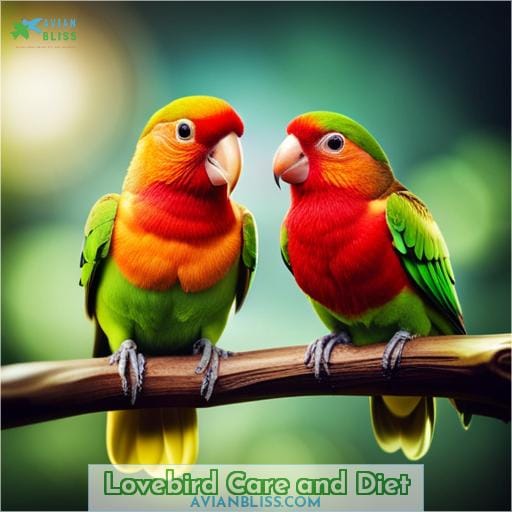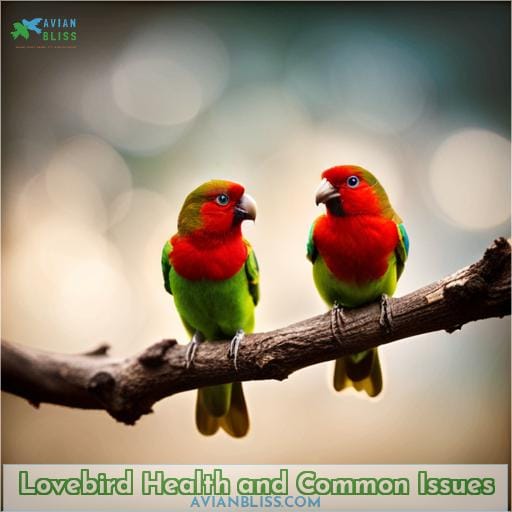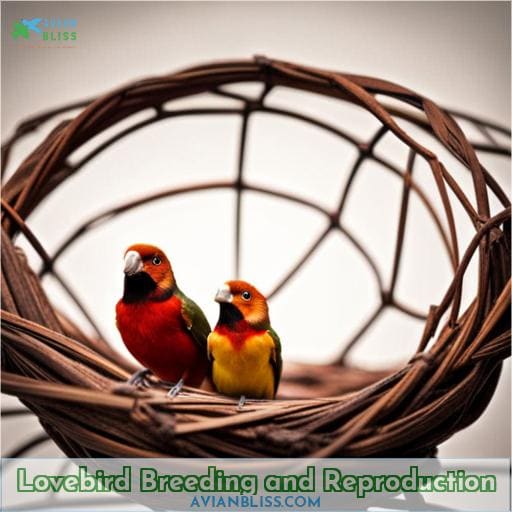This site is supported by our readers. We may earn a commission, at no cost to you, if you purchase through links.
 Imagine you’re about to enter the enchanting world of lovebirds. These charming and intelligent birds are known for their affectionate nature, captivating colors, and unique behaviors. But before you dive headfirst into owning a pair of these delightful creatures, there are some important facts that you should know.
Imagine you’re about to enter the enchanting world of lovebirds. These charming and intelligent birds are known for their affectionate nature, captivating colors, and unique behaviors. But before you dive headfirst into owning a pair of these delightful creatures, there are some important facts that you should know.
From their social tendencies to their specific care requirements, this article will provide all the essential information you need to ensure a happy and healthy life for your lovebirds.
Table Of Contents
- Key Takeaways
- Lovebird Basics
- Lovebird Species
- Lovebird Lifespan and Size
- Lovebird Behavior and Temperament
- Lovebird Communication
- Lovebird Care and Diet
- Lovebird Health and Common Issues
- Lovebird Breeding and Reproduction
- Lovebird Training and Socialization
- Considerations Before Getting Lovebirds
- Frequently Asked Questions (FAQs)
- Can lovebirds be trained to talk like other parrot species?
- Are lovebirds suitable for people living in small apartments or confined spaces?
- Do lovebirds need to be kept in pairs or can they thrive alone with human interaction?
- How much exercise and mental stimulation do lovebirds require on a daily basis?
- What are some general traits and characteristics of lovebirds that potential owners should be aware of?
- Conclusion
Key Takeaways
- Lovebirds are small parrots known for their strong pair bonds and affectionate nature.
- They require proper care and diet to ensure their well-being and longevity.
- Lovebirds thrive on bonding with their owners or other lovebirds.
- They are susceptible to various health issues, including chlamydiosis, respiratory infections, and nutritional deficiencies.
Lovebird Basics
Lovebird Basics are an essential foundation for understanding these captivating birds.
You may be wondering, what exactly are lovebirds?
Well, lovebirds are small parrots known for their strong pair bonds and affectionate nature.
They got their name from the way they display their deep affection towards each other through cuddling and preening rituals.
What Are Lovebirds?
Lovebirds are small parrots that make delightful pets due to their charming personalities and vibrant plumage. Originating mainly from Sub-Saharan Africa, they thrive in forests and savannas.
Lovebirds form strong pair bonds and prefer social interaction within their groups.
With their bold nature and chatty behavior at dawn or dusk; lovebirds have a unique personality that makes them captivating companions for those seeking intimacy with a feathered friend.
Why Are They Called Lovebirds?
Because of their strong pair bonding and affectionate nature, lovebirds earned the name lovebirds as a nod to their reputation for forming deep emotional connections with their mates.
These small parrots are known for their ability to bond not only with each other but also with other birds in the wild. Their courtship behavior involves displays of affection such as preening, feeding, and vocalizations.
Lovebird species exhibit a wide range of temperaments and have specific dietary needs that require proper nutrition to ensure good health.
Lovebird Species
When it comes to lovebird species, there are several common ones with unique characteristics that you should know.
Each species has its own distinct traits and qualities that make them special. Understanding the differences between these species will help you choose the right lovebirds for your preferences and needs as a pet owner.
Common Lovebird Species
While discussing lovebird basics, it’s important to delve into the common lovebird species and their unique characteristics.
Lovebirds are native to Africa, with different species like African and European lovebirds exhibiting distinct traits.
Each species has its own personality traits and vocalizations that make them fascinating pets.
Understanding the different lovebird species can help you choose the right one for adoption or purchase based on your preferences.
Unique Characteristics of Each Species
Each lovebird species possesses unique characteristics that set them apart from one another.
- Beak shape: Varies between short and stout to longer and more slender.
- Wing length: Ranges from shorter wings suitable for flying in dense forests to longer wings for open habitats.
- Plumage color: Vibrant hues including green, red, yellow, blue, or a combination of these colors.
Lovebird Lifespan and Size
Lovebirds have a lifespan of up to 20 years and measure between 5 and 7 inches in size.
On average, lovebirds live for about 10 to 15 years, but some can live as long as 29 years.
These charming birds are known for their small size, typically ranging from around 5 to 6 inches in length. They weigh approximately 1.5 to 2 ounces. The smallest species of lovebird measures just 3.
These facts about love birds’ lifespan and size are important considerations before getting a pair as pets. They require proper care including regular veterinary check-ups, to ensure their health is maintained throughout their lives.
Lovebirds thrive when provided with a balanced diet consisting of seeds, fruits, vegetables, and other nutritional supplements appropriate for maintaining optimum health.
With the right care and attention, you can create an intimate bond with these delightful creatures that will last many joyful years.
Lovebird Behavior and Temperament
Lovebird behavior and temperament are important factors to consider when deciding to get a pair of these birds.
Lovebirds have a social nature and thrive on bonding with their owners or other lovebirds. Pairing is common among lovebirds, but it’s also possible for single birds to be happy with dedicated human interaction.
Social Nature of Lovebirds
To understand the social nature of lovebirds, it’s important to recognize that these birds thrive on companionship and interaction with both their own kind and humans.
Lovebirds form strong pair bonds and establish a social hierarchy within their flock.
They exhibit flocking behavior, relying on each other for safety and support.
Lovebirds also engage in social learning, observing others’ behaviors to acquire new skills or knowledge.
However, territoriality can lead to aggression if boundaries are crossed.
Communication plays a vital role in lovebird interactions as they communicate through various vocalizations and respond to social cues from their peers or human caretakers.
Their ability to empathize shows emotional intelligence within these small but fascinating creatures.
Bonding and Pairing
When it comes to bonding and pairing, lovebirds thrive on social interaction with both their avian companions and human caregivers. Socialization is crucial for their well-being as they’re highly sociable creatures.
It’s important to note that there can be differences between the sexes in terms of behavior and temperament.
To pair birds successfully, introduce them gradually while monitoring signs of stress or aggression. Providing a safe environment and spending quality time together can help facilitate bonding between lovebirds.
Lovebird Communication
Lovebird communication is a fascinating aspect of their behavior.
These birds are known for their vocalizations and sounds, which they use to communicate with each other.
Additionally, some lovebirds have the ability to mimic certain sounds or even words, although this isn’t as common as in larger parrot species.
Understanding lovebird communication can help you better understand and interact with these charming birds.
Vocalizations and Sounds
If you’ve ever owned a lovebird, you know that these delightful birds aren’t shy about expressing themselves through their vocalizations and sounds.
- Chirping at various frequencies to convey different messages.
- Producing a variety of calls and whistles to express emotions like happiness or distress.
- Using different pitch levels to communicate with other birds or humans.
- Adjusting volume levels based on the situation, from soft murmurs to loud squawks.
Lovebirds’ vocalizations offer insight into their thoughts and feelings, creating an intimate connection between them and their owners.
Mimicking Abilities
Lovebirds have the remarkable ability to mimic simple sounds and household noises.
While not all lovebirds can talk, those that do are known for their impressive vocalizations.
They can learn words and phrases, often with surprising clarity.
However, it’s important to note that some lovebirds may develop speech impediments or lisps while attempting to mimic human language.
Additionally, these clever birds can also mimic other birds and animals in their environment, showcasing their adaptability and intelligence in communication.
Lovebird Care and Diet
Now let’s delve into the important aspects of lovebird care and diet.
Ensuring proper housing and cage setup is crucial for their well-being, while understanding their feeding and nutritional needs is essential for maintaining optimal health.
Let’s explore these points further to provide you with a comprehensive guide on how to care for your lovebirds.
Housing and Cage Setup
To ensure the well-being of your lovebirds, provide them with a suitable housing and cage setup.
- Choose a cage that’s spacious enough for them to move around comfortably, with appropriate size and shape.
- Place the cage in an elevated position that’s well-lit and away from drafts.
- Include perches and toys to keep your birds entertained and active.
- Consider adding nest boxes if you plan on breeding or egg laying.
- Regularly clean the cage for proper maintenance and hygiene.
Feeding and Nutrition
Maintaining a proper diet and nutrition is crucial for the health and well-being of your lovebirds.
- Provide a balanced seed mix as the base of their diet.
- Supplement with fresh fruits and vegetables for added nutrients.
- Establish a consistent food schedule to ensure they receive regular meals.
Don’t forget to provide clean water in a bowl at all times.
Lovebird Health and Common Issues
Now let’s turn our attention to the health and common issues that lovebirds may face. It’s important to be aware of these potential problems so you can provide proper veterinary care and maintenance for your feathered friends.
By understanding the common health problems that lovebirds may encounter, you can take proactive steps to ensure their well-being and address any issues promptly.
Common Health Problems
If you own lovebirds, it’s important to be aware of the common health problems that can affect them.
Some potential issues include chlamydiosis and respiratory infections, which can cause respiratory distress and other symptoms.
Lovebirds are also prone to conditions like egg binding and prolapse, where they’ve difficulty laying eggs or their reproductive organs protrude.
Feather plucking and self-mutilation may occur due to stress or boredom.
Nutritional deficiencies, particularly vitamin A deficiency, can lead to various health problems as well.
Lastly, obesity is a concern in lovebirds that requires proper weight management for their overall well-being.
Veterinary Care and Maintenance
Regular veterinary care and maintenance are essential for keeping your lovebird healthy and addressing any potential health issues.
Taking your lovebird to the vet for annual visits ensures that their overall health is monitored, and any problems can be detected early on.
Some important aspects of veterinary care include:
- Regular health checks
- Administering medication when necessary
- Beak trimming using specialized tools
Additionally, a proper diet with appropriate supplements contributes to their overall well-being.
Lovebird Breeding and Reproduction
When it comes to Lovebird breeding and reproduction, there are some important facts you should know.
Lovebirds are known for their strong pair bonds and mate for life. They engage in courtship behaviors such as feeding each other and preening, which ultimately leads to the female laying eggs in a nest they build together.
Mating Behavior
When it comes to lovebird breeding and reproduction, you may be interested in understanding their unique mating behavior.
Lovebirds are known for their strong pair bonding and courtship rituals. They engage in various behaviors like mutual preening, feeding each other, and singing together to strengthen their bond.
Compatibility between mates is crucial as aggression can arise if the pair isn’t well-matched.
Lovebirds also have distinct mate preferences based on factors such as appearance and personality traits.
Nesting and Egg Laying
To successfully breed lovebirds, you should provide them with a suitable nesting area and be aware of their natural egg-laying behaviors.
Lovebird eggs typically have an incubation period of around 23 to 30 days.
The size of lovebird eggs can vary depending on the species but usually range from 0.
It’s important to provide a nest box that’s spacious enough for the birds and allows sufficient room for the clutch size, which can consist of approximately four to six eggs.
Lovebird eggs come in various colors including white, cream, or pale blue with speckles or markings on them.
Once you’ve set up an appropriate nesting area for your breeding pair of lovebirds and understand their natural egg-laying behaviors, it’s essential to know more about some specific details regarding this stage in their reproductive process.
Firstly, when it comes to incubating (or sitting) on the eggs after they’re laid by female lovebirds (also known as hens), both parents take turns sharing this responsibility until eventually hatchlings emerge from inside those fragile shells.
Regarding egg sizes among different species within Agapornis genus – such as Fischer’s Lovebirds versus Peach-faced ones -, there might be slight variations: while most commonly observed measurements fall between roughly three-quarters inches long up through one full inch measured tip-to-tip across its widest part; however smaller-sized clutches could produce even tinier offspring measuring closer towards half-inch marks instead!
As mentioned earlier above already though we’ll reiterate here again just how crucial providing adequate space throughout every phase during mating rituals remains vital if successful reproduction desired rather than mere attempts at procreating resulting fruitlessly without any viable young being produced whatsoever due insufficient accommodations made available beforehand leading disappointment frustration experienced owners left wondering what went wrong where things derailed off course along way keeping mind necessary requirements met whether talking about overall cage dimensions appropriate nest box size specifically designed cater specific needs particular species involved.
Lastly, the overall clutch size for lovebirds can typically range anywhere from four up to six eggs. However, it’s vital not to disturb or handle them too much during this period as excessive human intervention may lead to stress and potentially affect their viability.
Lovebird eggs come in various colors such as white, cream, pale blue with speckles or markings on them – adding a touch of beauty and uniqueness throughout the breeding process.
Lovebird Training and Socialization
When it comes to training and socializing lovebirds, there are a few key points to keep in mind.
First, taming and hand-feeding can help build trust between you and your bird.
Teaching tricks and behaviors is another way to engage their intelligent minds and provide mental stimulation.
By understanding these aspects of lovebird training, you can create a strong bond with your feathered friend while keeping them happy and well-behaved.
Taming and Hand-Feeding
If you want to establish a strong bond with your lovebirds, it’s important to start taming and hand-feeding them from an early age.
Make the process gradual, with patience, treats, and positive reinforcement.
Approach with your hand slowly and allow them to eat treats from your palm.
As they become comfortable, progress to perching on your finger.
Stay calm and reward desired behaviors.
Daily handling sessions will build trust and form a close companionship.
Teaching Tricks and Behaviors
Having tamed and hand-fed your lovebird, you’re ready to start training it to perform simple tricks and behaviors through positive reinforcement.
Use a clicker or verbal cues paired with rewards like treats or praise.
Patience and consistency are key as you gradually introduce new commands and reinforce desired behaviors.
Remember to keep training sessions short, fun, and engaging for your lovebird to ensure successful learning experiences.
Considerations Before Getting Lovebirds
Before diving into the world of lovebirds, there are a few key considerations to keep in mind.
First and foremost is the time and commitment required to care for these birds, as they thrive on attention and affection.
Additionally, you’ll need to consider the space available in your home and the noise level that lovebirds can create.
Lastly, if you have other pets at home, it’s important to assess their compatibility with lovebirds before bringing them into your household.
Time and Commitment
Before bringing lovebirds into your home, it’s important to consider the time and commitment required to properly care for these social birds.
Daily interaction and training time are essential, as well as weekly cage maintenance and health checkups.
Breeding lovebirds also requires substantial time for bonding, egg laying, and nest maintenance.
The active nature of lovebirds necessitates a considerable commitment to their daily and veterinary care needs.
Space and Noise Level
When considering getting lovebirds, it’s important to take into account the space they’ll require and the noise level they may produce.
Lovebirds are active birds that need ample room for flight and exercise. A cage size of 32 x 20 x 20 per pair is recommended.
Additionally, lovebirds can be noisy with their vocalizations, especially during social interactions or when feeling territorial.
It’s essential to consider your living situation and tolerance for noise before bringing home these charming but sometimes noisy pets.
Compatibility With Other Pets
If you have other pets at home, it’s important to consider their compatibility with lovebirds.
Lovebirds can be territorial and may exhibit aggression towards other animals, especially dogs and cats. It’s crucial to introduce them in a controlled environment and monitor their interactions closely.
Fish or reptiles may not pose the same threat but should still be kept separate from lovebird cages to prevent stress for both parties involved.
Frequently Asked Questions (FAQs)
Can lovebirds be trained to talk like other parrot species?
Yes, lovebirds can be trained to talk, but it’s not as common as with other parrot species.
They may mimic simple sounds or household noises.
Their intelligence and charm make them captivating pets regardless.
Are lovebirds suitable for people living in small apartments or confined spaces?
Lovebirds are a perfect fit for small apartments or confined spaces due to their compact size and manageable needs. Their intelligence, charm, and social nature make them delightful companions even in limited living areas.
Do lovebirds need to be kept in pairs or can they thrive alone with human interaction?
Lovebirds can thrive alone with ample human interaction.
While some believe they need to be kept in pairs, it’s a myth.
Single lovebirds enjoy quality time and bond well with their owners, fulfilling their social needs while living in small apartments or confined spaces.
How much exercise and mental stimulation do lovebirds require on a daily basis?
Lovebirds require a substantial amount of exercise and mental stimulation on a daily basis.
Providing them with at least 2 hours of activity outside the cage is essential for their physical well-being and overall mental health.
What are some general traits and characteristics of lovebirds that potential owners should be aware of?
Lovebirds possess captivating traits that make them irresistible companions.
Their active and social nature, coupled with their intelligence, will keep you entertained for hours on end.
They’re like tiny balls of joy, radiating warmth and love in your home.
Conclusion
To sum it up, lovebirds are fascinating and enchanting creatures that make wonderful pets. Their affectionate nature, captivating colors, and unique behaviors make them a joy to have around.
However, before getting a pair of lovebirds, it’s important to understand their specific care requirements and behaviors. From their social tendencies to their communication style, there’s a lot to learn about these delightful birds.
By providing them with the right environment, diet, and socialization, you can ensure a happy and healthy life for your lovebirds.

